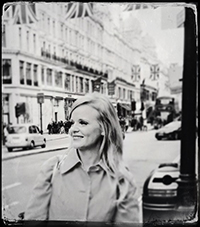How I Became an Instructional Designer: Athena
In the last few years I’ve noticed an increase in the number of questions I’ve been asked by visitors to Arizona State University about the Instructional Designers on our team, Instructional Design & New Media, in EdPlus. People want to know about their backgrounds and academic credentials, how we find them, how we hire them, how they work as a team, how they manage their workloads, and more. It occurred to me as I answered these questions that there is a lot I don’t know about how the Instructional Designers in our group arrived at their jobs. I decided to interview some of the team to find out more about the paths they’ve taken to get here. Along the way, I was fortunate enough to have access to some of our colleagues at King’s College, London, with whom we work as part of the PLuS Alliance. In the end, I was able to interview six Instructional Designers from ASU and three from King’s College. My goal is to include Instructional Designers from our other PLuS Alliance partner, University of New South Wales, in the future.
The following includes highlights, pivotal life moments, and milestones that came out in the conversations. One post in the series will be published here at the TeachOnline website each week for nine weeks.
Athena (40) – Phoenix – ASU
I was born in Rapid City, South Dakota, and was raised in Newcastle, Wyoming, where I lived until I graduated high school and left for the University of Wyoming in Laramie. There were about 80 students in my high school graduating class, and about 11 of us went to college.
 My family owned a convenience store, a Conoco gas station in Newcastle. The convenience store was called the Short Stop, and my mother was a bookkeeper and a tax accountant who did not have any education other than what her father transferred to her, since he had been an accountant and bookkeeper.
My family owned a convenience store, a Conoco gas station in Newcastle. The convenience store was called the Short Stop, and my mother was a bookkeeper and a tax accountant who did not have any education other than what her father transferred to her, since he had been an accountant and bookkeeper.
I like to consider myself one of those people who is always curious about lots of things. Some of the first memories I have are playing school, where I was always the principal or the teacher, and my sister had to be the student. I was in charge of the classroom, and even when we played library, I was the librarian, and she had to come and check out the books. She often would want to switch roles, so she could play the librarian or the principal, but I didn’t like that. It was usually, “We play school my way, or we don’t play school.”
I loved school, and I had perfect attendance from kindergarten through twelfth grade; I did not miss a single day, not even for illness. In grade school I always wanted to go into teaching, and I always wanted to be a principal because that’s all I knew back then, and I didn’t know about a lot of other career fields as a young person. Part of me always thought that at one point I might own my own business, because mom owned her accounting business and the convenience store.
I loved painting, drawing, artwork, and making crafts. I thought, “Oh, I could make things and start a business and sell the things I make.” I was always thinking about ways I could make money, so I had a Kool-Aid stand every summer for years outside of my grandpa’s accounting office. I didn’t just sell Kool-Aid, though, I also sold little hand-made craft items for five or ten cents to the neighbors and to my grandpa’s tax clients.
I learned a lot about business through my Kool-Aid stand. My parents tried to teach me things like what money I was putting in and what money I was getting out. I thought, “Well, I’m not putting anything in, because I’m getting the sugar out of the cupboard and the Kool-Aid from the other cupboard. The water comes out of the sink. This was a really low-cost investment.” They taught me about how you actually have to buy the sugar and Kool-Aid first, so I learned a lot about business through being raised in a family that owned businesses.
Toward the end of high school, I applied to five colleges, but I didn’t know exactly where I wanted to go, so I decided I would go to whatever school admitted me. Well, all five sent me acceptance letters. I applied for every scholarship application that was offered through my high school, and I decided I would go wherever I get the most scholarships. And I received the most scholarships to go to the University of Wyoming.
I ended up really having some personal struggles. My stepdad at the time called the school and said, “I’m worried about our daughter. Can you check on her?” The Dean of Students called me in, and thought I was in some kind of terrible trouble only to find out that they just wanted to check on me. They said, “You’ve got almost a 4.0 GPA. You’re doing great. You’re not necessarily at risk by our standards.” I said, “I’m not sure why they called you, but it could be because I feel like I have to work and I don’t have a job. I need help finding a job.” They hired me on the spot to work in the Dean of Students office where I worked the rest of my undergrad career. Once I had a job, I thrived in college. I loved college.
I worked for Charlotte Davis, the Assistant Dean of Students, and she became my mentor. She was a very classy, well-connected woman who was a wonderful role model for me. She was just the type of person who was lacking in my life, in terms of women to look up to. She took me under her wing and helped me along the way, teaching me many of the skills that I use today. She taught me time management, stress management, and all the other vital skills a college student needs.
My undergrad degree was focused on Communication and Spanish. Once I started taking communication courses, I realized that it was a blend of all these things that interested me. Then I happened upon the bachelor’s in Spanish because I enjoyed it and even studied abroad twice. So, I graduated with both degrees, but it was only later during my master’s degree work when I realized how much I loved teaching. That’s when I started to pursue the PhD in education.
Over the course of my life, I moved around a lot. I worked at the University of Wyoming as a student activities coordinator. I worked in student services at Cal State San Bernardino as an admissions advisor for a couple of years. Then we ended up moving to Arizona because we wanted to find a place with a better cost of living. Once I went back to Wyoming, I said, “Okay, I’ve got to finish this PhD!”
At some point, though, I had to think long and hard about what I could do for work that offered a good income and that would best fit my personality. I took all kinds of personality tests to figure out what I’d be good at, and of course, educator came up very high on the list, but so did sales and persuasion. I decided that I’d had too much experience in education. and wanted to branch out, so I tried an alternate career path. I read a book on how to secure a pharmaceutical sales job, and the author recommended that you hit the pavement, walk around hospitals and medical facilities, and introduce yourself to people. He also stated that you should not be afraid to approach people, always take a resume and business card, and be prepared to explain who you are and what you can do. I followed the advice, and all the people I approached were impressed that I was dressed in a nice suit and went out and pounded the pavement. They took me in and scheduled some interviews, and I was hired relatively quickly, after just one day of a series of interviews by Pfizer. So, I did a short stint as a pharmaceutical sales representative, and while I did pretty well with it, I didn’t love it. I was struggling to get out of bed in the morning to go to work. I could do the job easily, but I just didn’t love it like I loved going to work in an education environment.
Changing career paths, I was hired by University of Wyoming as an instructional technologist. I had worked with the instructional designers as a grad student, and that’s how I became interested in instructional design and online teaching and learning. This was my transition into the academic side of higher education. Once I entered the online world, I really realized how amazing and how far-reaching it was. I just knew I wanted to be part of it, this wave of the future. I boarded that ship and embraced it into the future, because that’s where we’re going.
I applied here at ASU because I thought, “I had better get myself an instructional designer job before I have a PhD on my resume. Once I have that degree, I’m sure they won’t hire me.” I seriously thought I would not be hired because I would be seen as a researcher or faculty person who wouldn’t qualify for instructional design.
I’ve always said to others and to myself, that work ethic is something ingrained in you or that you’re born with. It’s hard to teach people a really good work ethic. I think people can acquire skills, but I think that innate drive or willingness or goal to work is sometimes within you. I’ve always enjoyed work; I love it; I thrive in it. I can’t see my life without having something that I’m passionate about working on.
Marc: What one piece of advice would you give to your 18-year-old self?
Get a full-time job through your undergraduate career so you don’t have student loan debt. Honestly, if I had known how much my education was going to cost me — to the point that I have to work multiple side jobs to pay it off in the time frame in which I want to — I would have worked harder and done more of a part-time education to get here. In hindsight, I wish someone would have told me to just to be more financially holistic and prepared while I went to college.
Additional editing: Debra Sims



